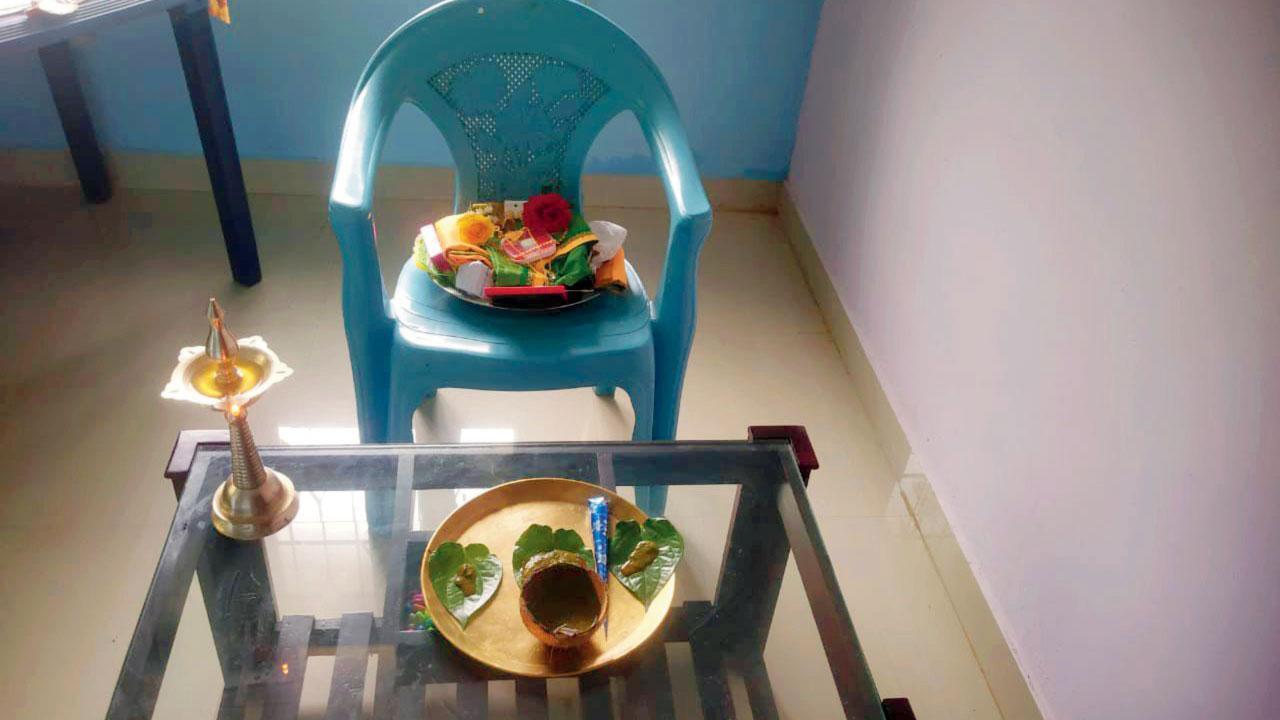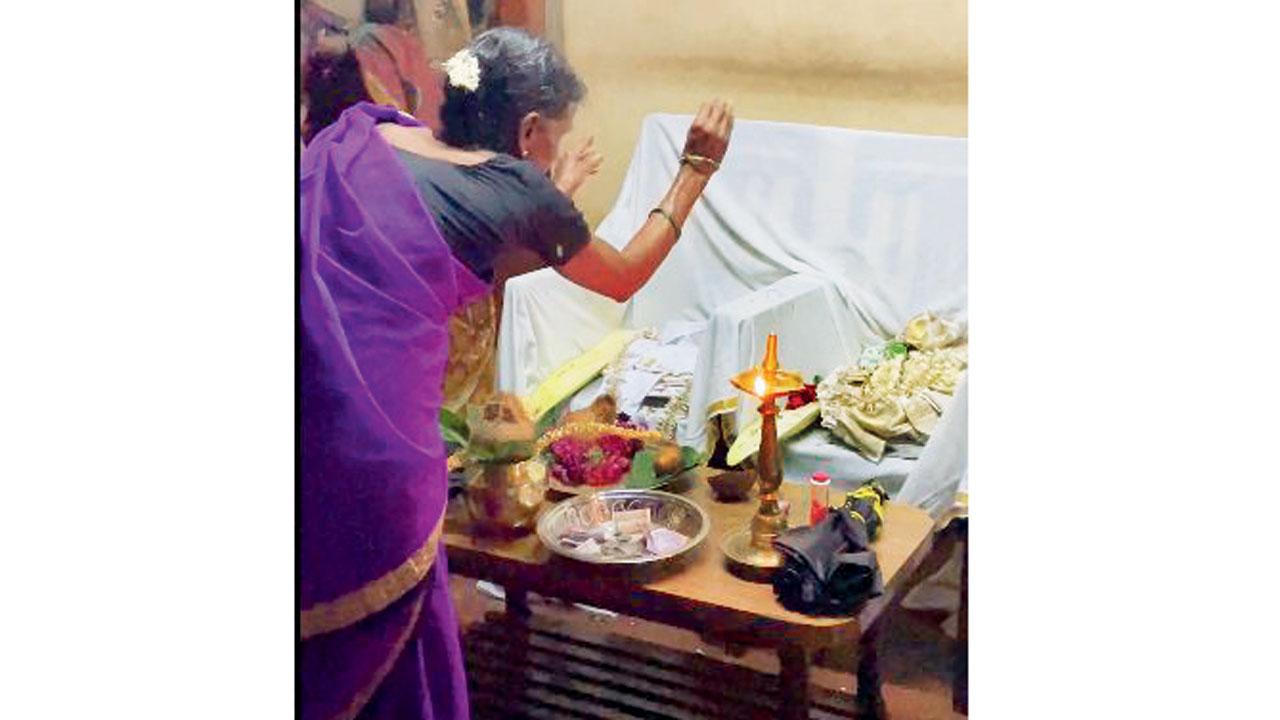A viral video sheds light on the ancient Tulu custom of Pretha Kalayanam or marriage of souls

Shobha’s Mehndi ceremony being performed on July 28. The thaal (plate) placed on the chair with folded clothes symbolises the bride
Shobha was draped in a white-and-gold silk South Indian saree. The jasmine in her hair filled the room with its fragrance, and her jewellery sparkled like the sun. Her groom, Chandappa, complemented her in his white-and-gold shirt and panche (lungi). However, Shobha and Chandappa have been dead for 30 years. That didn’t stop their families from solemnising their wedding on July 28 in the Dakhshina Kannada district in Tulu Nadu.
ADVERTISEMENT
Jayanthi Kulal, a 60-year-old resident of Karnataka, lost her daughter Shobha 28 years ago, barely 25 days after she was born. In the course of time, had she lived, Jayanthi would have had the pleasure of seeing Shobha married. As per the ancient Tulu tradition of Pretha Kalayanam, two departed souls can be joined in matrimony in the Aati month of theTulu calendar (July or August).
“At 28, my daughter would have been of marriageable age,” says Jayanthi. “We discussed it with the elders of the family, and after reaching an agreement, started looking for a groom. Now that she’s married, we feel she is happy and at peace. We are also at peace now that we have fulfilled our duty. We no longer have nightmares; we are sure she is happy on the other side.” In Tulu households, there’s a deeply held belief that if a family is going through a hard time, it is an indication that a dead relative or child is not happy in the other world.

Pretha Kalayanam performed for Shobha and Chandappa who died three decades ago
Arun Kumar Moolya, a software engineer from Karnataka, helped translate Jayanthi’s comments for us. The 36-year-old attended his cousin Shobha’s wedding and tweeted about it. The thread has garnered over 40,000 likes and 15,000 retweets. Moolya is also a YouTuber who documents his motorbike expeditions around the country. “As per Tulu tradition, these ceremonies are marriages of souls that can take place on Amavasya,” he says. “Normal functions such weddings and celebrations are not held in this month; only the vows of the dead are solemnised—of those who departed at birth or as children. Unmarried people and children are not allowed to attend these functions.”
As with any matrimonial tie, gotras are checked, castes are matched, socio-economic levels are considered, astrological charts checked for compatibility, before the dead can embark on their happy ever afterlife. “My mother told me of an instance where a bride was rejected because she was older than the groom,” says Moolay. Believers say the unusual tradition has a facet of healing. “It is an oral folk tradition which became a ritual that served as a salve for grieving parents and family members,” says Dayanand Kathalsar, Tulu Sahitya Academy president. It provides closure.
The rituals can be cathartic. Jayanthi pounded and made mehendi for Shobha on July 28, and applied it on the betel leaves kept on a chair to symbolise the bride. At 5 pm, the wedding procession left the house bearing gifts and adornments for the groom, Chandappa. A large thaal with the nuptial saree, hair extentions adorned with flowers, a mangalsutra, among other ornaments, represent Shobha. Before entering the groom’s house, married women from both families formed two queues and exchanged kumkuma, perfume and holy water. Chandappa’s sister then took the “bride’s hand” by holding a corner of the saree, and led her into the home for the ceremony to begin. “After this, they ‘gave’ Shobha another saree, blouse, jewellery and flowers. They also carried the groom’s headgear, the lungi, shirt and jewellery on a similar plate.
The bride and groom (represented by the gift-laden thaalis) sat on chairs and the rituals began. They took three circumambulations of the oil lamp and the bride’s side performed kanyadaan, symbolising that Shobha now belonged to Chandappa’s family and her wellness was their responsibility, explains Moolya. Food is served, gifts are exchanged and the families become relatives for life. Here on, they will include each other in their ceremonies and rituals.
“But the bride doesn’t go to live with the groom after the ceremony,” says Moolya. “She comes back to her husband’s house after a couple of days, and makes annual visits to her mother’s house in the Aati month of every year.” Unlike South Indian weddings that take place in the morning, soul unions take place at godhooli bela (dusk), according to a muhurat pre-decided by priests.
“Legend holds that there was once a family where the elder daughter died young,” says Kathalsar. “When the time came for her siblings to get hitched, they began pining for their sister, hoping she could be present at the celebrations. They imagined her helping the bride or groom dress up, and play her part in the rituals.”
This pining, says Kathalsar, ran so deep that the younger sister started behaving as the dead elder sister. She told her family that marriage would make her happy. “Seeing this as a manifestation of the subconscious mind, the healers of the time considered the wedding ritual to be a healing process for the family that would help them move on. This became a tradition. Kathalsar’s own family performed the wedding of his dead maternal aunt 10 years ago. “The tradition has been kept alive for thousands of years,” he says.
 Subscribe today by clicking the link and stay updated with the latest news!" Click here!
Subscribe today by clicking the link and stay updated with the latest news!" Click here!







